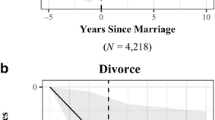Abstract
This paper proposes and tests an alternative explanation of the marriage premium that relies upon differences in workers' tastes and compensating wage differentials. A key assumption is that marital status proxies for the consumption of family goods — such as children; and that these are costly. Workers whose greater demands for family goods are taste-generated are shown to choose jobs that offer greater wage, and lesser nonpecuniary compensation. This creates an observed wage premium that has nothing to do with differences in workers' productivities. Supporting empirical evidence for this hypothesis is presented, including a reevaluation of previous studies.
Similar content being viewed by others
References
Abraham K, Farber H (1987) Job duration, seniority, and earnings. Am Econ Rev 77:278–296
Altonji J, Shakotko R (1987) Do wages rise with job seniority? Rev Econ Stud 54:437–459
Bartel A (1982) Wages nonwage job characteristics, and labor mobility. Industrial Labor Relat Rev 35:578–589
Becker G (1981) A treatise on the family. Harvard University Press Cambridge
Becker G (1985) Human capital, effort, and the sexual division and labor. J Labor Econ 3:533–558
Brown C (1980) Equalizing differences in the labor market. J Econ 94:113–134
Cain G (1986) The economic analysis of labor market discrimination: a survey. Handb Labor Econ 1:694–785
Carliner G (1980) Wages, earnings, and hours of first, second, and third generation american males. Econ Inquiry 18:87–102
Cotton J, Tuttle J (1986) Employee turnover: a meta-analysis and review with implications for research. Acad Manag Rev 11:55–70
Duncan G, Leigh D (1985) The endogeneity of union status: an empirical test. J Labor Econ 3:385–402
Duncan G, Holmlund B (1983) Was Adam Smith right after all? Another test of the theory of compensating wage differentials. J Labor Econ 1:366–379
Gorman W (1976) Tricks with utility function. In: Artis M, Nobay R (eds) Essays in economic analysis. Cambridge University Press, Cambridge
Grenier G (1984) The effects of language characteristics on the wages of Hispanic-American males. J Hum Resourc 19:35–51
Hall R, (1982) The importance of lifetime jobs in the U.S. Economy. Am Econ Rev 72:716–724
Hill M (1979) The wage effects of marital status and children. J Hum Resourc 14:579–594
Kenny L (1983) The accumulation of human capital during marriage by males. Econ Inquiry 21:223–231
Kenny L, Lee L, Maddala, G, Trost P (1979) Returns to college education: an investigation of self-selection bias based on the project talent data. Int Econ Rev 20:775–789
Korenman S, Neumark D (1988) Does marriage really make men more productive? Working Paper # 29, Finance and Economics Discussion Series, Division of Research and Statistics, Federal Reserve Board, Washington, D.C., May 1988
Korenman S, Neumark D (1988) Marriage and the wages of women. Unpublished manuscript, Division of Research and Statistics, Federal Reserve Board, Washington, D.C.
Lucas REB (1974) The distribution of job characteristics. Rev Econ Statist 66:530–540
Lucas REB (1977) Hedonic wage equations and psychic wages in the returns to schooling. Am Econ Rev 67:549–558
Marshall R, Zarkin G (1987) The effect of job tenure on wage offers. J Labor Econ 5:301–321
Miller R, Wichern D (1977) Intermediate business statistics. Holt, Rinehart and Winston, New York
Mortensen D (1988) tEquilibrium wage distributions: a synthesis. Discussion Paper No. 811, The Center for Mathematical Studies in Economies and Management Science, Northwestern University, November 1988
Nakosteen R, Zimmer M (1987) Marital status and Earnings of young men. J Hum Resourc 22:248–268
Olson L, White H, Shefrin H (1979) Optimal investment in schooling when incomes are risky. J Pòlit Econ 87:522–539
Reed W, Holleman J (1989) Do women prefer women's work? Working Paper 89-03, Department of Ecomomics, Texas A&M University, February 1989
Rosen S, Taubman P (1982) Changes in life-cycle earnings: What do social security data show? J Hum Resourc 17:321–337
Smith R (1979) Compensating wage differentials and public policy: a review. Indust Labor Relat Rev 32:339–352
Sowell T (1976) Affirmative action reconsidered. Publ Interest 42:47–65
Sowell T (1981) Weber and Bakke, and the presuppositions of affirmative action. In: Block W, Walker M (eds) Discrimination, affirmative action, and equal opportunity. The Fraser Institute, Vancouver, B.C, pp 37–63
Tomes N (1984) The effects of religion and denomination on earnings and the returns to human capital. J Hum Resourc 19:472–487
Tregarthen T (1987) Women and jobs: still missing the boat? Margin 2:6–8
U.S. Bureau of the Census (1987) Statistical abstract of the United States: 1988. 108th Ed. Washington, D.C.
Author information
Authors and Affiliations
Rights and permissions
About this article
Cite this article
Reed, W.R., Harford, K. The marriage premium and compensating wage differentials. J Popul Econ 2, 237–265 (1989). https://doi.org/10.1007/BF00171003
Received:
Accepted:
Issue Date:
DOI: https://doi.org/10.1007/BF00171003




